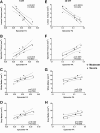Serial Diffusion Tensor Imaging In Vivo Predicts Long-Term Functional Recovery and Histopathology in Rats following Different Severities of Spinal Cord Injury
- PMID: 26650623
- PMCID: PMC4876527
- DOI: 10.1089/neu.2015.4185
Serial Diffusion Tensor Imaging In Vivo Predicts Long-Term Functional Recovery and Histopathology in Rats following Different Severities of Spinal Cord Injury
Abstract
The current study demonstrates the feasibility of using serial magnetic resonance imaging (MRI) and diffusion tensor imaging (DTI) in vivo to quantify temporally spinal cord injury (SCI) pathology in adult female Sprague-Dawley rats that were scanned prior to a moderate or severe upper lumbar contusion SCI. Injured rats were behaviorally tested for hind limb locomotion (Basso, Beattie, Bresnahan [BBB] scores) weekly for 4 weeks and scanned immediately after each session, ending with terminal gait analyses prior to euthanasia. As a measure of tissue integrity, fractional anisotropy (FA) values were significantly lower throughout the spinal cord in both injury cohorts at all time-points examined versus pre-injury. Moreover, FA values were significantly lower following severe versus moderate SCI at all time-points, and FA values at the injury epicenters at all time-points were significantly correlated with both spared white and gray matter volumes, as well as lesion volumes. Critically, quantified FA values at subacute (24 h) and all subsequent time-points were highly predictive of terminal behavior, reflected in significant correlations with both weekly BBB scores and terminal gait parameters. Critically, the finding that clinically relevant subacute (24 h) FA values accurately predict long-term functional recovery may obviate long-term studies to assess the efficacy of therapeutics tested experimentally or clinically. In summary, this study demonstrates a reproducible serial MRI procedure to predict the long-term impact of contusion SCI on both behavior and histopathology using subacute DTI metrics obtained in vivo to accurately predict multiple terminal outcome measures, which can be particularly valuable when comparing experimental interventions.
Keywords: BBB; anisotropy; contusion; gait analysis; magnetic resonance imaging (MRI); neuroimaging; white matter.
Figures











References
-
- Kirshblum S.C., Waring W., Biering-Sorensen F., Burns S.P., Johansen M., Schmidt-Read M., Donovan W., Graves D., Jha A., Jones L., Mulcahey M.J., and Krassioukov A. (2011). Reference for the 2011 revision of the International Standards for Neurological Classification of Spinal Cord Injury. J. Spinal Cord Med. 34, 547–554 - PMC - PubMed
-
- Ditunno J.F., Little J.W., Tessler A., and Burns A.S. (2004). Spinal shock revisited: a four-phase model. Spinal Cord 42, 383–395 - PubMed
-
- Nishi R.A., Liu H., Chu Y., Hamamura M., Su M.Y., Nalcioglu O., and Anderson A.J. (2007). Behavioral, histological, and ex vivo magnetic resonance imaging assessment of graded contusion spinal cord injury in mice. J. Neurotrauma 24, 674–689 - PubMed
-
- Spanevello M.D., Tajouri S.I., Mirciov C., Kurniawan N., Pearse M.J., Fabri L.J., Owczarek C.M., Hardy M.P., Bradford R.A., Ramunno M.L., Turnley A.M., Ruitenberg M.J., Boyd A.W., and Bartlett P.F. (2013). Acute delivery of EphA4-Fc improves functional recovery after contusive spinal cord injury in rats. J. Neurotrauma 30, 1023–1034 - PMC - PubMed
Publication types
MeSH terms
Grants and funding
LinkOut - more resources
Full Text Sources
Other Literature Sources
Medical
Research Materials

